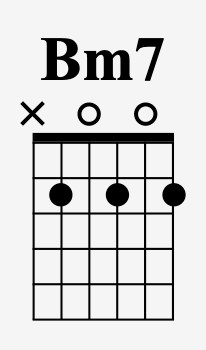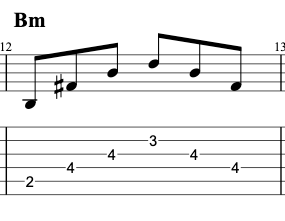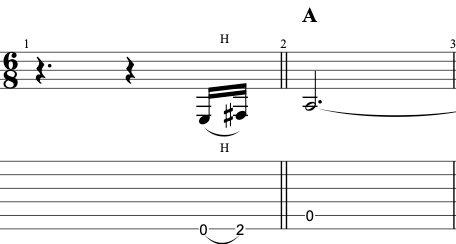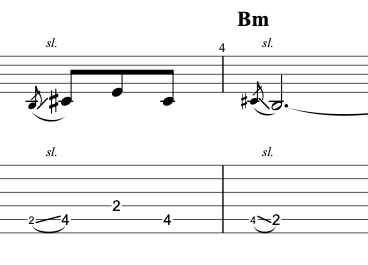"I'd Rather Go Blind" Guitar Lesson: Easy Step-By-Step Guide
If you're a guitarist looking to add some classic blues to your setlist, look no further than this "I'd Rather Go Blind" guitar lesson. This guide will walk you through chords, strumming patterns, and arpeggio-picking techniques you'll need to play in this soulful blues style.
I’d Rather Go Blind Chords
To play "I'd Rather Go Blind" on guitar, start by learning the chords and progression. This classic blues tune uses a simple chord progression of A to Bm, which loops continuously throughout the song. In this section, we'll go over the chord shapes you'll need to play this tune.
For A major play this:

And for Bm you can play this in the 2nd position like this:

Now a lot of the time players think of this Bm chord shape as being a bar chord. However, notice that you can just play it on the middle 4 strings, and this would require no baring at all. When you do this you want to mute off the low 6th and high 1st strings.
If that chord is too hard you could also substitute a Bm7 in its place like this:

This variation requires no baring, and here you’ll play every other string on the 2nd fret starting with the 5th string.
Next, you’ll want to take those chord shapes and drop them into the chord progression for the song. For this lesson, I’m counting “I’d Rather Go Blind” in a 6/8 time signature. This means that there are six eighth notes in a measure. So each bar I’ll count as 1,2,3,4,5,6 and then repeat.
- A (2 bars)
- Bm (4 bars)
- A (2 bars)
Start by just playing each chord once per bar and counting out loud 1,2,3,4,5,6, 1,2,3,4,5,6. This will help you to start getting the feel and groove of this song. When you’re ready, play that simple approach through the entire song, either with the recording or along with me in the video above.
Strumming Patterns & Arpeggio Picking
Once you have the basic chord progression and timing down for "I'd Rather Go Blind," it's time to start practicing different strumming and arpeggio-picking patterns to add some variety to your playing.
Here we are going to experiment with different patterns and rhythms, to try to match the feel of the song. Remember that this is no right or wrong here, the goal is just to play something that sounds good with the music or friends you are jamming with.
The above whole notes we practiced are a great rhythm to use, however, to add more movement and energy to your playing try using an eighth-note strumming pattern on all down strums like this:
D D D D D D
1 2 3 4 5 6
So instead of just strumming on the one and counting to 6, we are now going to strum on every single eighth note count.
Next, try adding in a backbeat accent. So play the same thing again but accent 1 and 4 a little bit harder in the strum hand like this:
> >
D D D D D D
1 2 3 4 5 6
At this point, you should be really starting to feel that groove. Remember to keep counting out loud. This is key to internalizing the feel.
Next, I want to share with you a classic rhythm and blues guitar technique that fits perfectly in this song, and that is arpeggio picking. The basic idea is that instead of strumming the chords, here we’ll break up the notes and pluck individual strings one at a time.
Instead of strumming those eighth notes well pluck one string at a time on each eighth note. The pattern needs to start with the root note of each chord. So for the A major and B minor chord shapes, we were using above, the root notes are both on the 5th string.
Start by plucking the 5th string and moving one string at a time all the way through to the 2nd string and then turn back like this:

Then the Bm follows the same picking pattern with the strum hand, however, the fretting hand is going to change chord shapes to Bm like this:

This technique requires more picking hand proficiency. When you start, hitting the strings you intend to will be difficult. Don't worry it’s not going to be perfect at first but the more you practice, the better you'll get!
Add in the Melody and Riffs
Once you have the chords and basic rhythm patterns down for "I'd Rather Go Blind," it's time to start incorporating some melodies and riffs into your playing. A great way to start doing this is by adding in some bass line fills.

The above example starts out with a pickup lick hammer-on from the open 6th string to the 2nd fret. After that play the open 5th string and let it ring out.
Example 2 shows an approach to the Bm chord. Begin by sliding up from the 2nd fret to the 4th fret on the 5th string. Then play the 2nd fret on the 4th string and slide back from the 4th fret to the 2nd fret on the 5th string. This phrase ends on the root note B right on the downbeat of the bar, just like the previous lick

Listen to the original recording of the song and try to pick out the melody and any riffs that are played throughout. This will add a new dimension to your playing and make the song sound more complete.
Put it All Together and Play Along with the Song
Now that you have learned the chords, strumming pattern, arpeggio picking, and riffs for "I'd Rather Go Blind," it's time to put it all together and play along with the song. Start by playing the chords and strumming pattern. Then, add in the more advanced parts as you feel more comfortable. It may take some practice to get everything coordinated, but keep at it and soon you'll be able to play the entire song from start to finish.
Conclusion:
"I'd Rather Go Blind" is a classic blues song that every guitarist should learn how to play. It’s got a simple chord progression and soulful lyrics. Remember to focus on your timing and rhythm counting out loud in 6/8 time signature. Once that feels comfortable you can mix it up by following the techniques outlined in this post. Keep practicing and you should be well on your way to mastering this timeless classic. If you enjoyed this lesson I think you'll really enjoy this "Life By The Drop" guitar lesson next in the same key!
Like this blog post? Get Jon’s best guitar lessons straight to your inbox.
